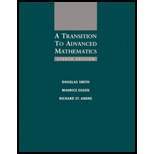
a.
Prove that an infinite subset of a denumerable set is denumerable.
a.
Answer to Problem 9E
Proved
Explanation of Solution
Given information:
Use the theorems of this section.
Calculation:
We have to use the theorem to prove an infinite subset of a denumerable set is denumerable.
A denumerable set
Every subset of a countable set is countable so
Since
Hence, an infinite subset of a denumerable set is denumerable.
b.
Prove that if
b.
Answer to Problem 9E
Proved
Explanation of Solution
Given information:
Use the theorems of this section.
Calculation:
We have to use the theorem to prove
Consider an uncountable set
It implies that set
The assumption
Hence, if
c.
Prove that
c.
Answer to Problem 9E
Proved
Explanation of Solution
Given information:
Use the theorems of this section.
Calculation:
We have to use the theorem to prove
The set
Hence,
d.
Prove that
d.
Answer to Problem 9E
Proved
Explanation of Solution
Given information:
Use the theorems of this section.
Calculation:
We have to use the theorem to prove
The set
The set
Since the set
Hence,
The set
Hence,
e.
Prove that
e.
Answer to Problem 9E
Proved
Explanation of Solution
Given information:
Use the theorems of this section.
Calculation:
We have to use the theorem to prove
The set
Hence,
f.
Prove that
f.
Answer to Problem 9E
Proved
Explanation of Solution
Given information:
Use the theorems of this section.
Calculation:
We have to use the theorem to prove
The set
Since the set of natural numbers is denumerable. the countable collection of countable sets is countable.
Hence,
Want to see more full solutions like this?
Chapter 5 Solutions
A Transition to Advanced Mathematics
- Find the order of each of the following elements in the multiplicative group of units . for for for forarrow_forwardLet a,b,c, and d be elements of a group G. Find an expression for (abcd)1 in terms of a1,b1,c1, and d1.arrow_forwardIn Exercises 13 and 14, part of the multiplication table for the group G={ a,b,c,d } is given. In each case, complete the table. See Figure 3.10. abcdabacad Figure 3.10arrow_forward
- In Exercises and , part of the multiplication table for the group is given. In each case, complete the table. 13. See Figure . Figurearrow_forwardThe alternating group A4 on 4 elements is the same as the group D4 of symmetries for a square. That is. A4=D4.arrow_forwardExercises 7. Let be an element of order in a group. Find the order of each of the following. a. b. c. d. e. f. g.arrow_forward
 Elements Of Modern AlgebraAlgebraISBN:9781285463230Author:Gilbert, Linda, JimmiePublisher:Cengage Learning,
Elements Of Modern AlgebraAlgebraISBN:9781285463230Author:Gilbert, Linda, JimmiePublisher:Cengage Learning,
